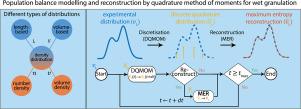Population balance modelling and reconstruction by quadrature method of moments for wet granulation
IF 4.5
2区 工程技术
Q2 ENGINEERING, CHEMICAL
引用次数: 0
Abstract
Population balance methods utilised in multiphase flow simulations mark a significant advancement in computational fluid dynamics. However, existing approaches exhibit shortcomings, such as being prone to inaccuracies or being computationally prohibitive. Addressing these challenges, a recent innovation in closure for the method of moments is the introduction of quadrature based moments methods (QBMM). Discretising a distribution by a number of discrete elements, QBMM facilitate efficient and accurate tracking of density distributions, particularly for particle size distributions (PSD). However, obtaining the full particle size distribution information using these methods requires reconstructing the distribution from a finite set of moments, which is not a trivial step.
This study introduces a novel combination of the maximum entropy reconstruction (MER) and QBMM, establishing a robust and rapid framework for the time evolution and reconstruction of PSDs. As proof of concept for this framework, we focus on the direct quadrature method of moments (DQMOM) with spatially homogeneous and monovariate distributions. We show that coupling of MER with DQMOM has numerous advantages. To verify the framework, special cases of constant growth, aggregation, and breakage are considered for which analytical solutions can be found. Furthermore, we show the advantage of using DQMOM with volume-based over length-based distributions, and address numerical as well as theoretical issues.
Application of the framework is successfully conducted on the evolution of the PSD from a twin-screw wet granulation dataset, considering all active primary physical mechanisms in a wet granulation process, namely growth, aggregation, and breakage. This showcases the consistency of the proposed framework and underscores its applicability to real-world scenarios.

用正交矩法为湿造粒建立种群平衡模型并进行重建
多相流模拟中使用的种群平衡方法标志着计算流体动力学的重大进步。然而,现有方法存在一些缺陷,例如容易出现误差或计算量过大。为了应对这些挑战,最近在矩量法闭合方面的一项创新是引入了基于正交的矩量法 (QBMM)。QBMM 通过一些离散元素对分布进行离散化,有助于高效、准确地跟踪密度分布,尤其是粒度分布 (PSD)。本研究引入了最大熵重构(MER)和 QBMM 的新组合,为 PSD 的时间演化和重构建立了一个稳健而快速的框架。作为该框架的概念验证,我们重点研究了空间均匀分布和单变量分布的直接正交矩法(DQMOM)。我们证明了 MER 与 DQMOM 的耦合具有诸多优势。为了验证该框架,我们考虑了恒定增长、聚集和断裂等特殊情况,并找到了解析解。此外,我们还展示了使用基于体积分布的 DQMOM 而非基于长度分布的 DQMOM 的优势,并解决了数值和理论问题。考虑到湿造粒过程中所有活跃的主要物理机制,即生长、聚集和破碎,我们在双螺杆湿造粒数据集的 PSD 演化中成功应用了该框架。这展示了所提出框架的一致性,并强调了其在现实世界中的适用性。
本文章由计算机程序翻译,如有差异,请以英文原文为准。
求助全文
约1分钟内获得全文
求助全文
来源期刊

Powder Technology
工程技术-工程:化工
CiteScore
9.90
自引率
15.40%
发文量
1047
审稿时长
46 days
期刊介绍:
Powder Technology is an International Journal on the Science and Technology of Wet and Dry Particulate Systems. Powder Technology publishes papers on all aspects of the formation of particles and their characterisation and on the study of systems containing particulate solids. No limitation is imposed on the size of the particles, which may range from nanometre scale, as in pigments or aerosols, to that of mined or quarried materials. The following list of topics is not intended to be comprehensive, but rather to indicate typical subjects which fall within the scope of the journal's interests:
Formation and synthesis of particles by precipitation and other methods.
Modification of particles by agglomeration, coating, comminution and attrition.
Characterisation of the size, shape, surface area, pore structure and strength of particles and agglomerates (including the origins and effects of inter particle forces).
Packing, failure, flow and permeability of assemblies of particles.
Particle-particle interactions and suspension rheology.
Handling and processing operations such as slurry flow, fluidization, pneumatic conveying.
Interactions between particles and their environment, including delivery of particulate products to the body.
Applications of particle technology in production of pharmaceuticals, chemicals, foods, pigments, structural, and functional materials and in environmental and energy related matters.
For materials-oriented contributions we are looking for articles revealing the effect of particle/powder characteristics (size, morphology and composition, in that order) on material performance or functionality and, ideally, comparison to any industrial standard.
 求助内容:
求助内容: 应助结果提醒方式:
应助结果提醒方式:


